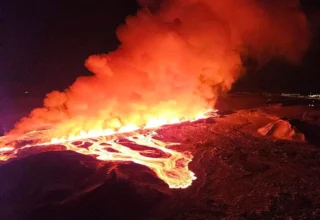
A volcano in southwestern Iceland erupted on Thursday for the third time since December, pumping lava up to 80 metres (260 feet) into the air and threatening to disrupt life in Reykjanes peninsula.
Video footage showed fountains of bright-orange molten rock spewing from cracks in the ground as daylight broke.
Volcanic outbreaks in the Reykjanes peninsula are so-called fissure eruptions, which do not usually cause large explosions or significant dispersal of ash into the stratosphere.
However, scientists fear they could continue for years, and Icelandic authorities have started building dykes to divert burning lava flows away from homes and critical infrastructure.
The latest eruptive fissure, the sixth outbreak since 2021, was roughly 3 km (2 miles) long, Iceland’s meteorological office said.
Intense earthquake activity began around 5:30 a.m. and the with the eruption itself starting 30 minutes later, it added.
A plume of smoke rose 3 km into the air, according to the Met Office. Still, Reykjavik’s international airport, around 20 km to the north west of the fissure, was operating as normal, airport operator Isavia said.
The nearby Blue Lagoon – a luxury geothermal spa – closed its doors on Thursday due to the volcanic outbreak.
The previous eruption in the area started on Jan. 14 and lasted roughly two days, with lava flows reaching the outskirts of the Grindavik fishing town, whose nearly 4,000 inhabitants had been evacuated, setting some houses alight.
Thursday’s eruption took place some way from Grindavik and was unlikely to pose a direct threat to the town, Icelandic geophysicist Ari Trausti Gudmundsson said.
“But it could pose some threat to the road to Grindavik and it could pose some threat to the power plant and even to the Blue Lagoon,” he said, adding that the risk depended on how much lava ultimately flowed from the ground.





























